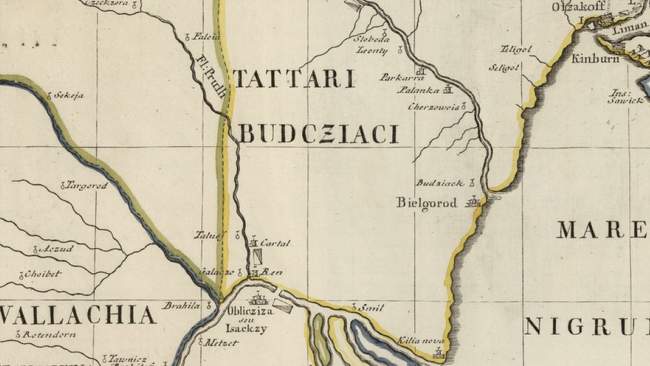Меню
Social networks
Sections
Dec. 15, 2024, 11:02 p.m.
Tatars and Nogays: How the Ottoman Empire Changed the Ethnic Composition of Budzhak
Цей матеріал також доступний українською744

The territory of the Budzhak Tatars on the map of 1737. Image: Wikipedia
Since the 1420s, the Ottoman state has been trying to recapture Bujak from the Moldavian principality. The main goal of the Ottomans was to control Kilia and Bilhorod-Dniester (Moncastro), which were the "sea gates of Moldova." The capture of the Danube ports meant control over the "Moldavian Way," which was a serious competitor to the "Great Silk Road" that passed through Constantinople. The intent continues to tell the story of the very interesting history of the south of Odesa region, the territory historically known as Budzhak.
In 1484, the Ottoman Porte finally conquered the Danube cities of Kilia and Bilhorod-Dnistrovskyi. During the fighting, they lost a significant number of their population. In particular, after the Ottomans captured Bilhorod-Dnistrovskyi, more than 4,000 residents were given to devshirme, the forced recruitment of Christian children into the sultan's property, where boys were trained for military and administrative service, and girls for harem service. Usually, one child aged 5 to 18 was taken from 40 yards, and then the child was converted to Islam. Another 3,000 peasants from the surrounding villages were captured by the Janissaries and Tatars, and the city itself was renamed Ak-Kermen (later Akkerman).
Contemporaries recalled: "Only 200 families of fishermen remained in the city." In the captured Kilia, more than two thousand girls were given away as damsels in distress. In 1503, the Moldovan ruler Stephen the Great signed a peace treaty with Sultan Bayezid II, under which he fully recognized the Ottoman authority in the cities of Bujak. Kilia and Akkerman became Ottoman port cities, and the steppe lands were transferred to the Crimean Khan.
The primary task in restoring the economic potential of the region was the resettlement policy, which focused on increasing the number of Muslims here at the expense of nomadic Nogai people to develop the steppe. In 1546, the Crimean Khan Sahib Giray began to settle Nogai nomads from the Crimea in Budzhak. However, the resettlement policy of Suleiman I had a significant impact on the revival of the region's economy. By a decree of April 3, 1560, he allowed the Small Nogai Horde, which was subordinate to the Crimean Khanate, to move to Budzhak. The tribes of Mansur, Orak, Kasai, Mamai, Jeybolyk, Jedisan, Jetyshkul, Kungrat, and others settled here.
The resettlement took place in waves: in the middle of the sixteenth century, the Mansur and Dzhambulat families were the first to move, and in 1621, the Orumbet Oglu family moved in. In 1651, the Orak-oglu family was first mentioned, as it was fleeing as a result of the campaign of the Crimean khan Islam Giray III to Moldova. In 1673, the Lithuanian Tatars resettled in the villages of Orumbet Oglu.
The migration of the Nogai people led to the settlement of the region: at the beginning of the seventeenth century, the total number of Tatars was about 30-45 thousand people. According to Vladyslav Hrybovsky, the number of the horde was even higher: "...Since the time of Eulia Celebi, the number of Bujakivtsi has been 45 thousand families, or about 230 thousand people. If we take into account the fact that the Budzhak Horde did not migrate until 1770, and its socio-economic system did not show significant changes, we can assume that the number of its population remained within 250 thousand people for most of the eighteenth century."
Thus, the total population of the Budzhak ulus gradually increased. Thus, the Ottoman resettlement policy was an undeniable success.

Nogai warrior. Engraving by Blanchard Auguste. Image: localhistory.org.ua
Already in the early seventeenth century, the Budzhak horde settled the coastal strip between Kiliya and Akkerman, which is unusual for nomads, they settled in 80-90 settlements near the Danube, Yalpug, Katlabukh, and Kugurluy. The Italian traveler Marco Bandini counted 60 settlements, but in 1691 the spy L. F. Marsigli discovered more than 300 Tatar settlements in Budzhak. In the mid-eighteenth century, the French King Louis XV's consul in the Crimean Khanate, Claude Charles de Peyssonnel, reported 500 Tatar settlements. According to local historian Kubiakin, in 1792 there were many Tatar settlements around the Kagarlyk River, including Aolen, Mangit, Zanzurt, and Alemshi; near the Saka River, Beyuk, Kapr, and Beshelikayuzan; and near the Chaga River, Deoy-Murza.
According to the memoirs of Evliya Chelebi, the village of Khankyshla was a rather small settlement (50 houses), but some of the Tatar villages were significant for that time. The village of Küpryubashi near Tatarbunar had 200 houses. The village of Choplidzha was even larger, with 500 houses and a mosque. The khan's capital Kaushany, according to de Peissonnell, had a population of 25-30 thousand Tatars in the 1750s. In 1768, the traveler St. Priest counted 35-40 thousand inhabitants. According to the memoirs of the officers of the Nizhny Novgorod Regiment, in 1808 there were 500-600 houses in at least 3 Tatar villages and in Kaushany.

A Tatar settlement. Image: eng.travelogues.gr
The memories of contemporaries are confirmed by Russian officers. Ivan Kotliarevskyi, recalling the Russo-Turkish war of 1806-1812, cited the number of Tatar settlements in Budzhak. At that time, the region was divided into 4 tribal Nogai districts or districts: Orumbet-oglu, Oran-oglu, Izmail-Kanesi, and from the end of the eighteenth century, Yet-isinkoy (another name - Yedisan-nogai), which were generally called "Budzhak Tatarlerinum topragi" (Budzhak Tatar land), later - Kaymakamlik Kaushan. There were 39 settlements in the Izmail-Kanesi district, 36 in Oran-oglu, 61 in Yet-Isinkoy, and 76 in Orumbet-oglu, which in total amounted to 212 settlements. He estimated the number of the combat-ready population alone at 30 thousand people.
The researcher A. Shabashov noted an interesting fact: the name does not contain the Tatar concept of "kabilei", i.e. clan (tribe). For example: The Yedisan horde was called Kabilei-Nogai-Yedisan or "the tribe of the Nogai of Yedisan". He explained this by saying that the Budzhak Horde was not a mono-ethnic association, but consisted of different tribes of Nogai, Turkmen, Uzbeks, and Kyrgyz. Of course, this ethnic diversity affected the administrative division of the lands and their economic specifics.
The district of Izmail-Kanesi was located within the future Izmail district of the Bessarabian region, Orak-oglu and Yet-isinkoy (97 villages) on the lands of the Akkerman district, and Orumbet-oglu on the lands of the Kagul district within the borders of the first quarter of the nineteenth century (Bender and Tomarov qinutas).

The geographical boundaries of Budzhak according to the map of 1820. Image: izmail.es
The jurisdiction of the Crimean Khan extended to the Budzhak Horde until the conclusion of the Kuchuk-Kainarzhyr Peace in July 1774. Over time, all Nogai uluses (including the Budzhak one) gained independence from the khanate.
However, Bakhchisarai did not actually control the Budzhak people. Anti-Ottoman Tatar uprisings were recorded in 1603, 1624-1625, and 1637. In 1702-1703, the largest uprising of the Budzhak Horde took place, which was dissatisfied with the terms of the Peace of Karlovy Vary in 1699. The Tatars attacked the Ottoman garrisons in Izmail and Kiliya and waited in vain for a frosty winter to cross the Danube on ice and plunder the lands of Rumelia and Istanbul.
Fearing that Russian agents would incite the Budzhak Tatars against Porta, in 1777 Budzhak was completely subordinated to the direct authority of the Ottomans. The administration in Budzhak was carried out directly by the Ottoman governor, the Budzhak Kaymakam or Seraskir. Local administrative control of the Nogai districts was transferred to kadiyas (judges) in Kiliya, Izmail, Bendery, Tatarbunary, Khankyshli, and Tombasar (Dubosary).
This situation remained until the Russo-Turkish War of 1806-1812. In 1807, part of the horde (6.4 thousand families) succumbed to the terms of the Russians and moved to the Kuban, while the rest (15,000 families) fled to the Ottoman Empire across the Prut River. As a result of population migration, the steppe Budzhak was almost completely depopulated.
Андрій Шевченко











